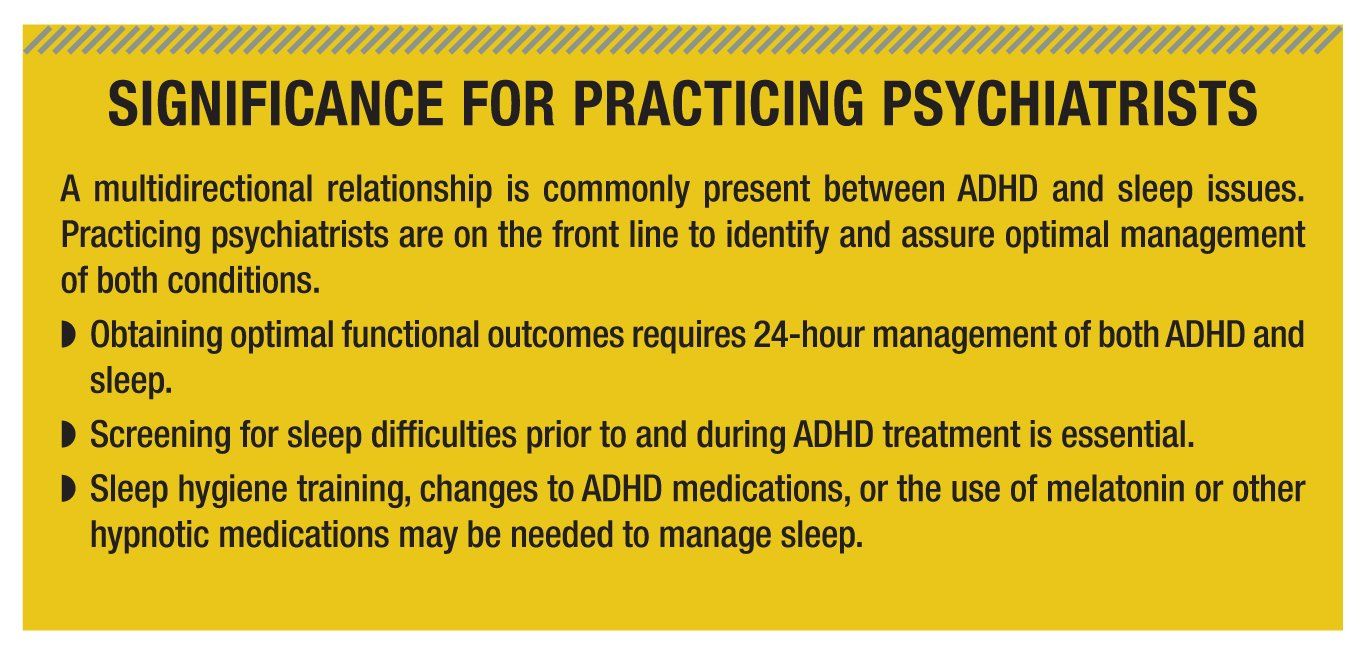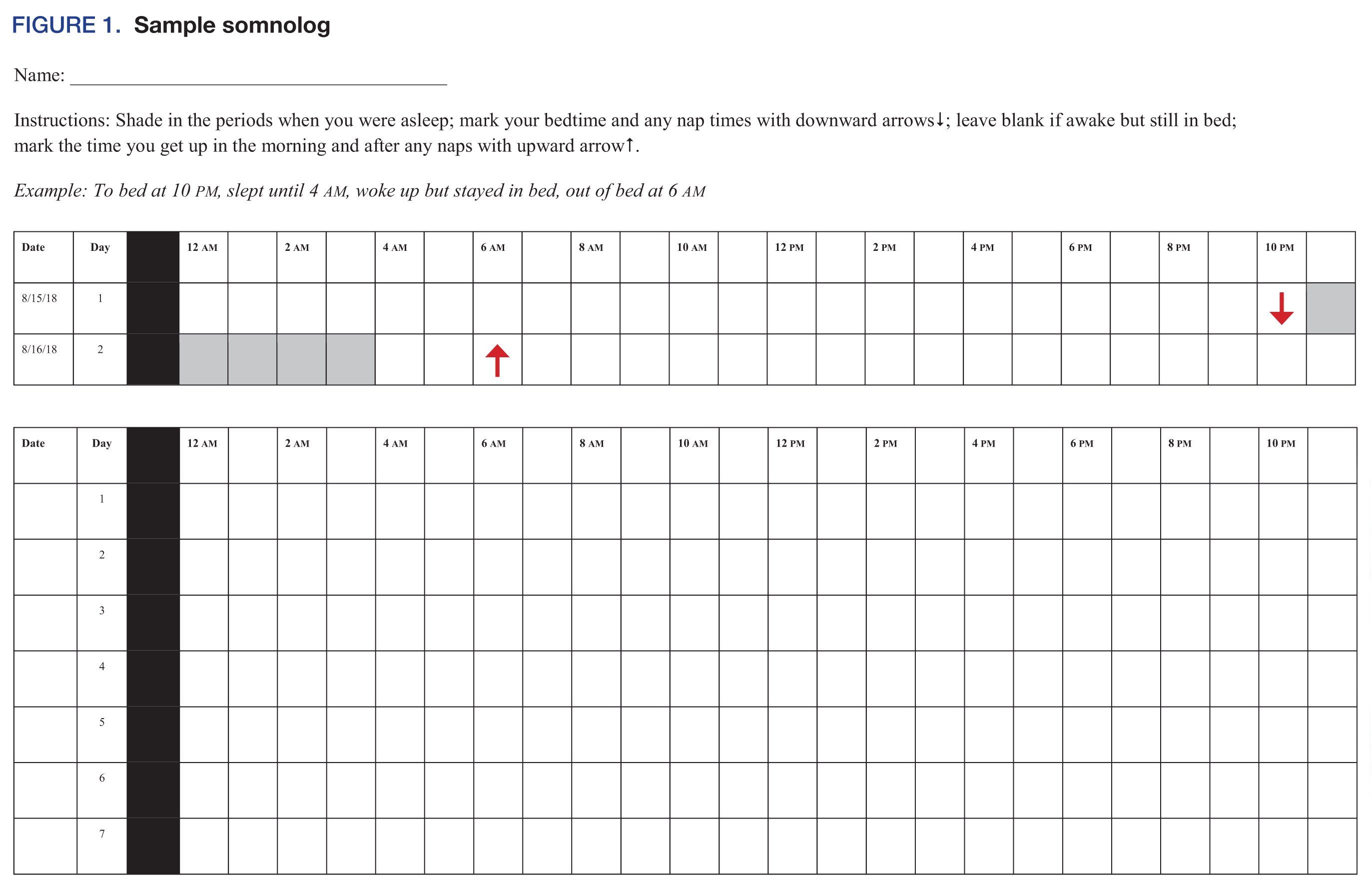Publication
Article
Psychiatric Times
ADHD: A 24-Hour Disorder
Sleep difficulties and sleep disorders are the most common comorbidities reported in individuals with ADHD. Careful assessment will lead to helpful interventions.
OnePhoto/Shutterstock.com

SIGNIFICANCE FOR PRACTICING PSYCHIATRISTS

TABLE. Subjective and objective measurements tools for sleep

FIGURE 1. Sample somnolog

Sleep difficulties and sleep disorders are the most common comorbidities reported in individuals with ADHD, affecting approximately 73% of children and adolescents with the condition and up to 80% of adults with ADHD.1,2 The high prevalence of sleep disorders in ADHD patients is a consistent finding, despite differences between studies with regard to population demographics and sleep assessment methodology (eg, subjective or objective measurement; see Table). There have been numerous reports detailing the multidirectional impact of sleep and ADHD on each other, noting that both sleep and ADHD related impairments may originate from common neurobiological pathways.
Bilateral comorbidity
Assessment of sleep disorders in patients with ADHD requires the clinician to disentangle the relationship between sleep and ADHD in individual patients. For example, a patient with ADHD may have a circadian rhythm sleep disorder that is being driven by difficulty going to bed or as an adverse effect of stimulants. Conversely, problems with attention and disinhibition can be a consequence of poor sleep, such as attention problems secondary to sleep disordered breathing. The relationship between ADHD and sleep can be conceptualized as a bilateral comorbidity in which there is an increase in risk for the comorbid condition when either is present. Furthermore, ADHD and sleep disorders both contribute to the patient’s functional impairment, even though it is the ADHD that is most often the target of clinical attention.
ADHD is inherently a disorder of self-regulation, circadian rhythm, overstimulation, and motor activity, which manifest both by day and by night. Difficulties with sleep and alertness associated with sleep disorders will lead to a pre-narcoleptic state consistent with the presentation of ADHD. Lecendreux and colleagues3 proposed that the agitated sleep, difficulty settling into sleep, and low arousal threshold of children with ADHD could result in hypovigilance that resembles the behavior of an overtired child who “gets a second wind” and becomes hyper or silly. The researchers tested for children with ADHD for sleepiness using the Mean Sleep Latency Test (MSLT) and found significant daytime sleepiness compared with controls. Moreover, daytime sleepiness was directly correlated with parent and teacher ADHD symptom ratings. They suggested that excessive nocturnal motricity might be the expression of a monoaminergic dysfunction.
This theory is relevant to many of the most common sleep disorders associated with ADHD, such as initial insomnia, circadian rhythm sleep disorder, restless legs syndrome, and periodic limb movement disorder. Sleep disordered breathing also makes sense as a risk factor for ADHD, in that hypoxia of any etiology will affect attention, self-control, and executive function. The “paradoxical” improvement in ADHD symptoms with stimulants also makes sense when considered within a theoretical framework that understands the overactivity of ADHD as the consequence of difficulty in regulation of nocturnal, daytime, and circadian rhythm regulation of alertness.
Over the past decade, the complex relationship between ADHD and sleep has become a focus of interest with a marked increase in number of publications. The research has led to a better appreciation of the subjective complaints of patients with ADHD that they “can’t turn their thoughts off.” Four main theories have been suggested as a conceptual model of the relationship between sleep and ADHD.4
First, it may be that sleep problems are a fundamental characteristic of ADHD, as suggested in DSM-III, which considered restless sleep one of the symptoms of ADHD. Second, sleep problems may mimic or cause symptoms that are characteristic of ADHD. Sleep difficulties have an impact on attention, executive functioning, and inhibition consistent with the symptoms of those with ADHD. Thirdly, ADHD and sleep problems may have a reciprocal relationship in that one disorder exacerbates the other in a vicious circle. Both ADHD and sleep problems are also often comorbid for internalizing disorders such as anxiety or depression where sleep difficulty is also part of the presentation. Lastly, it is possible that sleep and ADHD may share common etiological neurobiological pathways.
Assessment
It is now standard of care that an ADHD assessment also includes screening for difficulties with sleep, both initially and during treatment of ADHD. This includes asking about bedtime and time to fall asleep, excessive daytime sleepiness, awakenings, regularity and duration of sleep, and snoring (BEARS).5 Many patients with ADHD are constitutional short sleepers who do not complain of fatigue or excessive daytime sleepiness even though they are sleeping less than what is considered optimal or even average.
The simplest and most informative tool to assess multiple parameters of sleep is a somnolog: a visual representation of sleep (Figure). A somnolog provides an immediate visual representation of night to night variability, sleep onset latency, sleep duration, and an excellent map with which to measure response to sleep hygiene. For example, review of the somnolog with the patient makes it easy to illustrate how going out late Saturday night and sleeping in late Sunday morning makes it difficult to fall asleep Sunday night because of insufficient sleep debt during the day. This is particularly pertinent to providing education about sleep to adolescents.
Another pattern that becomes immediately apparent from review of a somnolog is the impact of one bad night on the rest of the week. This is particularly important in assessment of sleep in ADHD, where night to night variability is the rule rather than the exception. In fact, it was lack of appreciation for the impact of night to night variability as a critical variable of sleep difficulty that led to confusion regarding why sleep was such a strong subjective patient complaint in the absence of abnormalities on single night polysomnograms.6
Patients who start to log their sleep begin to appreciate the impact of consistent bed times and wake times on well-being. The visual representation of the alignment of their sleep patterns into a regular and entrained schedule becomes a symbol that encapsulates success in achieving sleep hygiene.
Clinicians should also familiarize themselves with standardized and well validated sleep scales. Screening tools for children include the Children’s Sleep Habits Questionnaire7 as a measure of sleep behavior and the Pediatric Sleep Questionnaire8 as a screen for sleep problems. For adults, two very useful scales are the Pittsburgh Sleep Questionnaire9 and the Epworth Sleepiness Scale10 to measure daytime somnolence.
In addition to the subjective measures of sleep described above, assessment of sleep can also include objective measurement through use of an actigraph. Actigraphs measure activity as a proxy for sleep; good actigraphs are generally found to be consistent with the data obtained from polysomnograms. Actigraphs are most useful for measurement of problems with circadian rhythm and night to night variability, which are typically problematic in ADHD. The simple actigraphs sold commercially as wearable devices are of questionable accuracy. Nonetheless, they have changed the landscape of public awareness by raising interest in self-monitoring of sleep. Clinicians who suspect that a patient may have narcolepsy, idiopathic hypersomnia, periodic limb movement disorder, rapid eye movement behavior disorder, parasomnias, or sleep apnea should make a referral to a sleep clinic for a polysomnogram and/or MSLT used to diagnose narcolepsy.
Interventions
The reality of clinical practice is that although sleep problems in patients with ADHD are common, impairing, and the source of considerable subjective distress, obtaining adherence to good sleep habits in patients with ADHD is difficult. Sleep hygiene recommendations are widely available and provide evidence-based patient recommendations (see American Academy of Sleep Medicine at sleepeducation.org or National Sleep Foundation at sleepfoundation.org for more information).
Typical sleep hygiene recommendations include maintaining a regular sleep/wake schedule, and avoiding caffeine, alcohol, naps, and electronic (ie, blue light) devices late at night. For children, Better Nights/Better Days11 may provide access to expert intervention. For adults, apps such as CBTi COACH (Cognitive Behavior Therapy for Insomnia) or SHUTi (Sleep Health Using the Internet) provide access to sleep education as well as a way to systematically measure response.
Evidence that melatonin is effective for initial insomnia in neurodevelopmental disorders has led to widespread and often long-term use by the public, especially where it is available over the counter. Exogenous melatonin use in the management of initial insomnia in ADHD has increased precipitously (10-fold in 10 years) where pharmacoepidemiologic studies are available such as the UK and Norway.12
Melatonin is viewed by the public as natural, but from the perspective of a physician it is clearly a pharmacological intervention. Unfortunately, the over-the-counter approval for melatonin has meant that it came into widespread use without any of the rigorous standards for quality control or safety testing that otherwise would have been required.
As a minimum, always inquire about use of melatonin, the dose, whether the formulation is long acting, how long the patient has taken melatonin, whether they have ever stopped using it, and what happens when they do. Clinicians should also inquire about common adverse effects of melatonin such as increased dreaming and middle of the night awakening.
Melatonin administered in small doses (.3 - .6 mg) has been used as a chronobiotic along with bright light to phase advance or phase delay sleep in patients with circadian rhythm sleep disorders.13 However, it is much more common to use melatonin as a hypnotic to assist with initial insomnia in doses between 1 and 10 mg administered a half hour before bedtime. This has been shown to be effective in decreasing sleep onset latency in multiple clinical trials and has become a common OTC method of dealing with insomnia in children with ADHD, even when it is induced by stimulants.14,15
Children on melatonin for insomnia who complain of the onset of nightmares or exacerbation of nightmares, should have a trial of melatonin discontinuation before initiation of a specific medication for nightmares such as prazosin. Despite these cautions, clinicians should be aware of the relative safety of melatonin compared with benzodiazepine/Z drugs or antipsychotics.
Psychiatric management of sleep problems
Psychiatric management of sleep problems in patients with ADHD requires evaluation of how medication treatment of ADHD is affecting sleep. This may involve reducing the total dose of stimulant, changing the dose regimen or formulation, adding a third dose of stimulants in the evening if sleep-onset delay is due to a rebound effect; changing to a different stimulant; changing to a non-stimulant; adding an alpha-2 agonist, or adding off label medications.
Sleep problems in ADHD are common, impairing and distressing to families, and off-label prescription of various medications as sleep aides are not uncommon. This may include medications such as clonidine, mirtazapine, hydroxyzine, diphenhydramine or trazodone. Patients with ADHD sleep difficulties, are often resistant to behavioral sleep interventions and may present to the psychiatrist having been managed in primary care with long-term hypnotics such as eszopiclone or zolpidem, sedative benzodiazepines, or sedative antipsychotics. The risk benefit profile for use of these drugs in the long term in this patient population has yet to be carefully studied.
Summary
It is apparent that ADHD is a 24-hour disorder. Optimal improvement in functional impairment requires effective management of both sleep challenges and ADHD symptoms. Using either objective or subjective measurement tools (or in combination) prior to any ADHD treatment is essential to rule out possible sleep disorders and to get a thorough analysis of current sleep health and hygiene. Psychiatrists are on the front line between primary care and sleep experts in assuring optimal management of both sleep and ADHD, and assuring these conditions are treated in a judicious way.
Psychiatrists need to be aware of both the risks associated with lack of sleep, as well as the risks of long-term use of off-label medications. Research on the complex relationship between sleep and ADHD has created a therapeutic opportunity. In the last decade, we have moved from recognition of sleep and ADHD as a common comorbidity, to evidence-based studies illustrating how treatment of sleep problems will affect ADHD, and treatment of ADHD can assist with sleep and sleep hygiene. Improved sleep can lead to improvement in ADHD, and improvement in ADHD (even with stimulants) can lead to improvements in sleep. Obtaining an optimal functional outcome for the patient requires 24-hour management of both ADHD and sleep.
Disclosures:
Dr Weiss is the Director of Child and Adolescent Psychiatry and Ms McBride is Clinical Research Associate, Psychiatric Research Institute, University of Arkansas for Medical Sciences in Little Rock, AR. Dr Weiss has received consulting and honorariums from Purdue Pharma, Rhodes Pharmaceuticals, Shire, and NLS Pharma; she has also received travel reimbursement from Rhodes, Shire, NLS Pharma, The Israeli Society for ADHD, and the World Federation of ADHD. Ms McBride has no conflicts of interest concerning the subject matter of this article.
References:
1. Sung V, Hiscock H, Sciberras E, Efron D. Sleep problems in children with attention-deficit/hyperactivity disorder: prevalence and the effect on the child and family. Arch Pediat Adoles Med. 2008;162:336-342.
2. Wynchank D, Bijlenga D, Beekman AT, et al. Adult attention-deficit/hyperactivity disorder (ADHD) and insomnia: an update of the literature. Curr Psychiatry Rep. 2017;19:98.
3. Lecendreux M, Konofal E, Bouvard M, et al. Sleep and alertness in children with ADHD. J Child Psychol Psychiatry. 2000;41:803-812.
4. Hvolby A. Associations of sleep disturbance with ADHD: implications for treatment. ADHD. 2015;7:1-18.
5. Owens JA, Dalzell V. Use of the “BEARS” sleep screening tool in a pediatric residents’ continuity clinic: a pilot study. Sleep Med. 2005;6:63-69.
6. Corkum P, Tannock R, Moldofsky H. Sleep disturbances in children with attention-deficit/hyperactivity disorder. J Am Acad Child Adolesc Psychiatry. 1998;37:637-646.
7. Markovich AN, Gendron MA, Corkum PV. Validating the Children’s Sleep Habits Questionnaire against polysomnography and actigraphy in school-aged children. Front Psychiatry. 2014;5:188.
8. Chervin RD, Hedger K, Dillon JE, Pituch KJ. Pediatric sleep questionnaire (PSQ): validity and reliability of scales for sleep-disordered breathing, snoring, sleepiness, and behavioral problems. Sleep Med. 2000;1:21-32.
9. Backhaus J, Junghanns K, Broocks A, et al. Test-retest reliability and validity of the Pittsburgh Sleep Quality Index in primary insomnia. J Psychosom Res. 2002;53:737-740.
10. Heaton K, Anderson D. A psychometric analysis of the Epworth Sleepiness Scale. J Nurs Meas. 2007;15:177-188.
11. Corkum P, Lingley-Pottie P, Davidson F, et al. Better Nights/Better Days-Distance Intervention for Insomnia in School-Aged Children With/Without ADHD: a randomized controlled trial. J Pediatr Psychol. 2016;41:701-713.
12. Hartz I, Handal M, Tverdal A, Skurtveit S. Paediatric off-label use of melatonin: a register linkage study between the Norwegian prescription database and patient register. Basic Clin Pharmacol Toxicol. 2015;117:267-273.
13. Lewy A. Melatonin and human chronobiology. Cold Spring Harb Symp Quant Biol. 2007;72:623-636.
14. Van der Heijden KB, Smits MG, Van Someren EJ, et al. Effect of melatonin on sleep, behavior, and cognition in ADHD and chronic sleep-onset insomnia. J Am Acad Child Adolesc Psychiatry. 2007;46:233-241.
15. Weiss MD, Wasdell MB, Bomben MM, et al. Sleep hygiene and melatonin treatment for children and adolescents with ADHD and initial insomnia. J Am Acad Child Adolesc Psychiatry. 2006;45:512-519.
Newsletter
Receive trusted psychiatric news, expert analysis, and clinical insights — subscribe today to support your practice and your patients.







